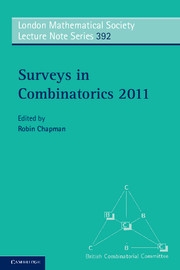Book contents
- Frontmatter
- Contents
- Preface
- 1 Counting planar maps, coloured or uncoloured
- 2 A survey of PPAD-completeness for computing Nash equilibria
- 3 Hypergraph Turán problems
- 4 Some new results in extremal graph theory
- 5 The cyclic sieving phenomenon: a survey
- 6 Order in building theory
- 7 Graphs, colours, weights and hereditary properties
- 8 Random geometric graphs
- 9 Transversals in latin squares: a survey
9 - Transversals in latin squares: a survey
Published online by Cambridge University Press: 05 August 2011
- Frontmatter
- Contents
- Preface
- 1 Counting planar maps, coloured or uncoloured
- 2 A survey of PPAD-completeness for computing Nash equilibria
- 3 Hypergraph Turán problems
- 4 Some new results in extremal graph theory
- 5 The cyclic sieving phenomenon: a survey
- 6 Order in building theory
- 7 Graphs, colours, weights and hereditary properties
- 8 Random geometric graphs
- 9 Transversals in latin squares: a survey
Summary
Abstract
A latin square of order n is an n×n array of n symbols in which each symbol occurs exactly once in each row and column. A transversal of such a square is a set of n entries containing no pair of entries that share the same row, column or symbol. Transversals are closely related to the notions of complete mappings and orthomorphisms in (quasi)groups, and are fundamental to the concept of mutually orthogonal latin squares.
Here we survey the literature on transversals and related notions. We cover (1) existence and enumeration results, (2) generalisations of transversals including partial transversals and plexes, (3) the special case when the latin square is a group table, (4) a connection with covering radii of sets of permutations, (5) transversals in arrays that generalise the notion of a latin square in various ways.
Introduction
By a diagonal of a square matrix we will mean a set of entries that contains exactly one representative from each row and column. A transversal is a diagonal in which no symbol is repeated. A latin square of order n is an n × n array of n symbols in which each symbol occurs exactly once in each row and in each column. The majority of this survey looks at transversals (and their generalisations) in latin squares. In a transversal of a latin square every symbol must occur exactly once, although in §10 we will consider transversals of more general matrices where this property no longer holds.
- Type
- Chapter
- Information
- Surveys in Combinatorics 2011 , pp. 403 - 437Publisher: Cambridge University PressPrint publication year: 2011
- 20
- Cited by



